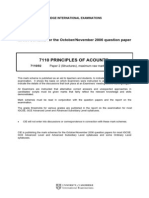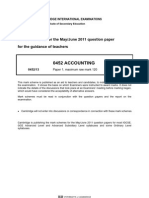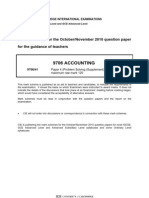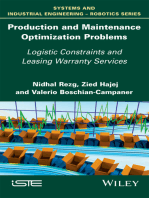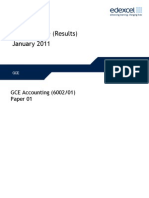9706 s10 Ms 43
9706 s10 Ms 43
Uploaded by
cherylllimclCopyright:
Available Formats
9706 s10 Ms 43
9706 s10 Ms 43
Uploaded by
cherylllimclOriginal Title
Copyright
Available Formats
Share this document
Did you find this document useful?
Is this content inappropriate?
Copyright:
Available Formats
9706 s10 Ms 43
9706 s10 Ms 43
Uploaded by
cherylllimclCopyright:
Available Formats
UNIVERSITY OF CAMBRIDGE INTERNATIONAL EXAMINATIONS
GCE Advanced Subsidiary Level and GCE Advanced Level
MARK SCHEME for the May/June 2010 question paper for the guidance of teachers
9706 ACCOUNTING
9706/43 Paper 43 (Problem Solving (Supplement)), maximum raw mark 120
This mark scheme is published as an aid to teachers and candidates, to indicate the requirements of the examination. It shows the basis on which Examiners were instructed to award marks. It does not indicate the details of the discussions that took place at an Examiners meeting before marking began, which would have considered the acceptability of alternative answers. Mark schemes must be read in conjunction with the question papers and the report on the examination.
CIE will not enter into discussions or correspondence in connection with these mark schemes.
CIE is publishing the mark schemes for the May/June 2010 question papers for most IGCSE, GCE Advanced Level and Advanced Subsidiary Level syllabuses and some Ordinary Level syllabuses.
Page 2 1 (a)
Mark Scheme: Teachers version GCE AS/A LEVEL May/June 2010 Capital accounts
Syllabus 9706
Paper 43
D N A D N A $ $ $ $ $ $ 1.7.09 Goodwill (1) 6 000 6 000 6 000 1.1.09 bals b/d (1) 24 000 18 000 31.12.09 bals c/d 27 000 21 000 94 000 1.7.09 Premises (1) 100 000 (1)of (1)of (1)of 1.7.09 Goodwill (1) 9 000 9 000 33 000 27 000 100 000 33 000 27 000 100 000 1.1.10 bals b/d 27 000 21 000 94 000 Ofs if no extraneous items and balances carried down correctly. (b) Income statements (Trading and profit and loss accounts) and appropriation accounts for the 6 months ended 30 June 2009 $ Sales (1 mark for 188 000) Opening inventory (stock) Purchases Closing inventory (stock) Gross profit Loss of disposal (10-2.5-6.5) Other costs Rent Depreciation equipment premises Interest Bad debts Profit for the period (net profit) Salary A Interest D Interest N Interest A Share of profit D Share of profit N Share of profit A (2) 22 000 105 000 (1) 21 000 1 000 (1) 51 000 3 000 (1) 2 500 (1) 1 000 (1) 600 ) (1) 450 ) 11 725 ) (1)of 11 725 ) 23 450 0 $ 189 000 106 000 83 000 31 December 2009 $ (1) 21 000 127 000 (1) 28 000 57 000 3 100 (1) 350 (1) 1 200 (1) 8 000 (1) 1 080 (1)of 840 (1)of 3 760 (1)of $ 247 000 120 000 127 000 [7]
58 500 24 500
61 650 65 350 8 000
1 050
5 680
17 223 ) 17 223 ) (1)of 17 224 ) 51 670 0 [19]
UCLES 2010
Page 3 (c)
Mark Scheme: Teachers version GCE AS/A LEVEL May/June 2010 Current accounts N $ 3 500 (1) 11 000 15 000 8 325 D $ A $
Syllabus 9706
Paper 43
1.1.09 bal b/d 30.6.09 Drawings 30.6.09 bal c/d
19 325 18 500 0 1.7.09 bal b/d 6 325 31.12.09 Drawings (1) 12 000 14 000 18 000 31.12.09 bal c/d 14 628 10 984 26 628 20 325 28 984 2 262 (1)of
1.1.10 bal b/d
D N A $ $ $ 1.1.09 bal b/d 7 000 30.6.09 IOC (1)of 600 450 30.6.09 Sh profit (1)of 11 725 11 725 30.6.09 bal c/d 6 325 19 325 18 500 0 1.7.09 bal b/d 8 325 31.12.09 Salary (1)of 8 000 31.12.09 IOC (1)of 1 080 840 3 760 31.12.09 Sh profit (1)of 17 223 17 223 17 224 31.12.09 bal c/d 2 262 26 628 20 325 28 984 1.1.10 bals b/d 14 628 10 984 (1)of (1)of [10]
For illustration only Balance sheet at 31 December 2009 Premises (100 000 350) Equipment (62 000 3 100) Stock Debtors Bank Creditors Loan Accrued interest Capital accounts Current accounts 99 650 58 900 28 000 24 000 16 000 20 000 40 000 1 200 165 350 D N A 27 000 21 000 94 000 142 000 14 628 2 262 10 984 23 350 165 350
Bank = 6 000 + 428 000 + 6 500 + 40 000 221 000 3 500 62 000 108 000 70 000 = 16 000 (d) Any reasonable answers, e.g. Advantage strengthening of asset base with an increase in fixed assets in balance sheet. Disadvantage increased risk of debt. (2 2) [4] [Total: 40]
UCLES 2010
Page 4 2
Mark Scheme: Teachers version GCE AS/A LEVEL May/June 2010
Syllabus 9706
Paper 43
(a)Income statement (profit and loss account) and appropriation account for the year ended 31 December 2009 Operating profit Interest Profit before tax Tax Net profit Ordinary dividend Preference dividend General reserve Retained profit $ 192 000 12 000 180 000 36 000 144 000 54 000 12 000 30 000 48 000 (1)of (1) (1)of (1)of (1)of (1) (3) (1) (1)of Interest 16 PBT 20%
(0.22 600 000) 144 000 = 12 000 (1)of (1)of (1)of (b) Balance sheet at 31 December 2009 Non-current (fixed) assets Net current assets 6% debentures 2018 $ 610 000 420 000 1030 000 200 000 830 000 300 000 (1) (1)of (1)
[11]
600 000 ordinary shares of $0.50 (1) (1) 240 000 5% preference shares of $1 240 000 (1)of (1)of Share premium 150 000 (1)of General reserve 30 000 (1) Profit and loss 110 000 (1)of 830 000
62 000 + 48 000 [10]
(c) (i) Dividend cover
144 - 12 54 2.50 0.22 9 100 250
2.44 times
(2)of
(ii) PER
11.36:1
(2)
(iii) Dividend yield
3.60%
(2)
(iv) Gearing ratio
200 + 240 300 + 200 + 240 + 150 + 30 + 110 440 42.7% (5) (1 mark for any two = 1030 components plus 1 for answer)
192 (1)of 100 = 18.64% 1 030 (1)of
(v) ROCE
(1)of
[14]
UCLES 2010
Page 5
Mark Scheme: Teachers version GCE AS/A LEVEL May/June 2010
Syllabus 9706
Paper 43
(d) V has higher gearing, higher risk. ROCE of V is higher, but return after interest may not be better. V may pay interest at a higher rate with a premium for the added risk. V has lower dividend cover, hence less assurance of dividends continuing. Vs profits, otherwise available for dividend, are being diverted to pay interest. Other reasonable comment.
[5] [Total: 40]
(a) Overhead absorption rate
(i) by machine hour
42 760 2 800 + 3 000 (1) (1) 42 760 2 100 + 1 800 (1) (1)
= $7.37 per m/hr (1)of = $10.96 per lab/hr (1)of
(ii) by labour hour
(iii) by total DM cost
42 760 = $0.66 per $ 34 440 + 30 800 (1) for both (1)of
[8]
(b) DM DL Ohds Profit
3.5 $8.8 1.8 $10 3 $7.37 50%
30.80 18.00 22.11 70.91 35.46 106.37
(1) (1) (1)of (1)of (1)of [5]
(c) Overabsorption of overheads: This means that the amount of overheads added to production costs exceeds the total amount of overheads, because actual production was higher than anticipated when the OAR was calculated. Underabsorption of overheads: This means that the amount of overheads added to production costs is less than the total amount of overheads, because actual production was lower than anticipated when the OAR was calculated. (2 2) [4] (d) (i) MPV (ii) MUV (iii) Total material variance (iv) LRV (v) LEV (vi) Total labour variance 2 760 A 1 640 F 1 120 A 440 A (2) (2) (2)of (2) (2) (2)of [12]
2 000 F 1 560 F
UCLES 2010
Page 6 (e) 4 672/1 600 125 760/1 600 Std price
Mark Scheme: Teachers version GCE AS/A LEVEL May/June 2010 $2.92 (1) $78.60 (1) $81.52 (1)of
Syllabus 9706
Paper 43
[3]
(f) Advantages: Budgets are easier to prepare. Budgets are more realistic. Needed for responsibility accounting. Enables management to understand why actual performance differs from budgets. Facilitates preparation of quotes etc. (4 2)
[8] [Total: 40]
UCLES 2010
You might also like
- Final Exam Corporate Finance CFVG 2016-2017Document8 pagesFinal Exam Corporate Finance CFVG 2016-2017Hạt TiêuNo ratings yet
- Data Interpretation Guide For All Competitive and Admission ExamsFrom EverandData Interpretation Guide For All Competitive and Admission ExamsRating: 2.5 out of 5 stars2.5/5 (6)
- Project of Export MarketingDocument28 pagesProject of Export MarketingMuhammad Habibullah Khan Jadoon80% (5)
- 0452 s10 Ms 21Document8 pages0452 s10 Ms 21cleverheart123No ratings yet
- 7110 s12 Ms 21Document7 pages7110 s12 Ms 21mstudy123456No ratings yet
- 7110 Principles of Acounts: MARK SCHEME For The October/November 2006 Question PaperDocument6 pages7110 Principles of Acounts: MARK SCHEME For The October/November 2006 Question Papermstudy123456No ratings yet
- 7110 w10 Ms 2Document7 pages7110 w10 Ms 2mstudy123456No ratings yet
- 0452 s11 Ms 13Document8 pages0452 s11 Ms 13Athul TomyNo ratings yet
- 9706 s03 MsDocument17 pages9706 s03 MsShanavaz AsokachalilNo ratings yet
- 9706 s15 Ms 211Document8 pages9706 s15 Ms 211nistha4444_89385228No ratings yet
- Corporate Finance - Exercises Session 1 - SolutionsDocument5 pagesCorporate Finance - Exercises Session 1 - SolutionsLouisRemNo ratings yet
- 9706 w12 Ms 23Document7 pages9706 w12 Ms 23Diksha KoossoolNo ratings yet
- 0452 w15 Ms 22 PDFDocument10 pages0452 w15 Ms 22 PDFAnonymous ustYBQOaEB100% (2)
- 0452 s13 Ms 11Document8 pages0452 s13 Ms 11Naðooshii AbdallahNo ratings yet
- 7110 w12 Ms 21Document6 pages7110 w12 Ms 21mstudy123456No ratings yet
- Coimisiún Na Scrúduithe Stáit State Examinations Commission: Leaving Certificate 2008Document19 pagesCoimisiún Na Scrúduithe Stáit State Examinations Commission: Leaving Certificate 2008Talent MuparuriNo ratings yet
- Management Accounting: Page 1 of 6Document70 pagesManagement Accounting: Page 1 of 6Ahmed Raza MirNo ratings yet
- 7110 w12 Ms 22Document7 pages7110 w12 Ms 22mstudy123456No ratings yet
- Examinations: Subject 102 - Financial MathematicsDocument10 pagesExaminations: Subject 102 - Financial MathematicsClerry SamuelNo ratings yet
- FandI Subj102 200004 Examreport PDFDocument11 pagesFandI Subj102 200004 Examreport PDFClerry SamuelNo ratings yet
- 0452 w11 Ms 13Document7 pages0452 w11 Ms 13Faisal RaoNo ratings yet
- ASE 3902 - IAS - Revised Syllabus - Answers To Specimen Paper 2008 16307Document8 pagesASE 3902 - IAS - Revised Syllabus - Answers To Specimen Paper 2008 16307WinnieOngNo ratings yet
- 9706 Accounting: MARK SCHEME For The October/November 2009 Question Paper For The Guidance of TeachersDocument5 pages9706 Accounting: MARK SCHEME For The October/November 2009 Question Paper For The Guidance of TeachersSaad MansoorNo ratings yet
- ASE 3012 Revised Syllabus - Answers To Specimen Paper 2008Document8 pagesASE 3012 Revised Syllabus - Answers To Specimen Paper 2008luckystar2013No ratings yet
- 0452 s12 Ms 22Document9 pages0452 s12 Ms 22Faisal RaoNo ratings yet
- AnswersDocument8 pagesAnswersTareq ChowdhuryNo ratings yet
- 0452 m15 Ms 12Document9 pages0452 m15 Ms 12IslamAltawanayNo ratings yet
- Solution Far450 UITM - Jan 2013Document8 pagesSolution Far450 UITM - Jan 2013Rosaidy SudinNo ratings yet
- 0452 s15 Ms 23Document9 pages0452 s15 Ms 23zuzoyopi100% (1)
- 0452 w11 Ms 12Document8 pages0452 w11 Ms 12Faisal RaoNo ratings yet
- 0452 w07 Ms 3 PDFDocument9 pages0452 w07 Ms 3 PDFHassan PansariNo ratings yet
- Home Work Excel SolutionDocument16 pagesHome Work Excel SolutionSunil KumarNo ratings yet
- 9706 s10 Ms 22 PDFDocument7 pages9706 s10 Ms 22 PDFYousaf GillaniNo ratings yet
- LAUSDFirstInterimFinancial2011 12 OcrDocument77 pagesLAUSDFirstInterimFinancial2011 12 OcrSaveAdultEdNo ratings yet
- 9706 Accounting: MARK SCHEME For The October/November 2013 SeriesDocument5 pages9706 Accounting: MARK SCHEME For The October/November 2013 SeriestarunyadavfutureNo ratings yet
- 0452 Accounting: MARK SCHEME For The May/June 2014 SeriesDocument8 pages0452 Accounting: MARK SCHEME For The May/June 2014 SeriessimplesaiedNo ratings yet
- 9706 - May June 2010 - All Mark Scheme PDFDocument46 pages9706 - May June 2010 - All Mark Scheme PDFRobert Nunez100% (1)
- MARK SCHEME For The November 2004 Question PaperDocument8 pagesMARK SCHEME For The November 2004 Question Papermstudy123456No ratings yet
- ACCT105 Quizzes and SolutionsDocument8 pagesACCT105 Quizzes and SolutionsAway To PonderNo ratings yet
- Acct Specimen 2010Document6 pagesAcct Specimen 2010Abid AhmedNo ratings yet
- MARK SCHEME For The June 2004 Question PapersDocument9 pagesMARK SCHEME For The June 2004 Question PapersRobert EdwardsNo ratings yet
- Si7 - Tarquin (1) 9 22Document14 pagesSi7 - Tarquin (1) 9 22Luis Eduardo Perez GonzalezNo ratings yet
- 9 BBDocument5 pages9 BBIlesh DinyaNo ratings yet
- PPAC AssignDocument19 pagesPPAC AssignDerickMwansaNo ratings yet
- 7110 w11 Ms 21Document10 pages7110 w11 Ms 21mstudy123456No ratings yet
- Solution Assignment 4 Chapter 7Document9 pagesSolution Assignment 4 Chapter 7Huynh Ng Quynh NhuNo ratings yet
- ENG 412 Class Activity 2 Section 1M - KeysolutionDocument4 pagesENG 412 Class Activity 2 Section 1M - Keysolutionanasaoa2002No ratings yet
- Chapter 11 Supplemental Questions: E11-3 (Depreciation Computations-SYD, DDB-Partial Periods)Document9 pagesChapter 11 Supplemental Questions: E11-3 (Depreciation Computations-SYD, DDB-Partial Periods)Dyan Novia67% (3)
- 9706 w10 Ms 41Document5 pages9706 w10 Ms 41kanz_h118No ratings yet
- 9706 Accounting: MARK SCHEME For The October/November 2013 SeriesDocument7 pages9706 Accounting: MARK SCHEME For The October/November 2013 SeriesCambridge Mathematics by Bisharat AliNo ratings yet
- 2014 Accounting Specimen Paper 1 Mark Scheme PDFDocument8 pages2014 Accounting Specimen Paper 1 Mark Scheme PDFSpike RockNo ratings yet
- 9706 Y10 SM 2 PDFDocument6 pages9706 Y10 SM 2 PDFTinyiko BandaNo ratings yet
- ASE20098 Mark Scheme March 2019Document11 pagesASE20098 Mark Scheme March 2019Ti SodiumNo ratings yet
- BA303 - 1002057831 - Rahmandika Adipradana (Supplementary Examination)Document13 pagesBA303 - 1002057831 - Rahmandika Adipradana (Supplementary Examination)Pump AestheticsNo ratings yet
- Macro Economics: A Simplified Detailed Edition for Students Understanding Fundamentals of MacroeconomicsFrom EverandMacro Economics: A Simplified Detailed Edition for Students Understanding Fundamentals of MacroeconomicsNo ratings yet
- List of Key Financial Ratios: Formulas and Calculation Examples Defined for Different Types of Profitability Ratios and the Other Most Important Financial RatiosFrom EverandList of Key Financial Ratios: Formulas and Calculation Examples Defined for Different Types of Profitability Ratios and the Other Most Important Financial RatiosNo ratings yet
- Asset Rotation: The Demise of Modern Portfolio Theory and the Birth of an Investment RenaissanceFrom EverandAsset Rotation: The Demise of Modern Portfolio Theory and the Birth of an Investment RenaissanceNo ratings yet
- Location Strategies and Value Creation of International Mergers and AcquisitionsFrom EverandLocation Strategies and Value Creation of International Mergers and AcquisitionsNo ratings yet
- List of the Most Important Financial Ratios: Formulas and Calculation Examples Defined for Different Types of Key Financial RatiosFrom EverandList of the Most Important Financial Ratios: Formulas and Calculation Examples Defined for Different Types of Key Financial RatiosNo ratings yet
- A Comparative Analysis of Tax Administration in Asia and the Pacific: Fifth EditionFrom EverandA Comparative Analysis of Tax Administration in Asia and the Pacific: Fifth EditionNo ratings yet
- Production and Maintenance Optimization Problems: Logistic Constraints and Leasing Warranty ServicesFrom EverandProduction and Maintenance Optimization Problems: Logistic Constraints and Leasing Warranty ServicesNo ratings yet
- Greencoat Uk Wind Fund Prospectus - September 2014Document177 pagesGreencoat Uk Wind Fund Prospectus - September 2014hyenadogNo ratings yet
- NHPC AGM HighlightDocument2 pagesNHPC AGM HighlightAbhishekNo ratings yet
- Hottenstein Et Al. v. York Ice Machinery Corp.Document3 pagesHottenstein Et Al. v. York Ice Machinery Corp.StradivariumNo ratings yet
- MATHEMATICS 2007 UnprotectedDocument12 pagesMATHEMATICS 2007 UnprotectedOlswel AnddisonNo ratings yet
- DCF On Jubilant FoodworksDocument20 pagesDCF On Jubilant Foodworkskcufthatsh1t0No ratings yet
- SoS MidTerm ReportDocument17 pagesSoS MidTerm ReportDheeraj Kumar ReddyNo ratings yet
- CA Final SFM Solution May 2019 by CA Praviin MahajanDocument14 pagesCA Final SFM Solution May 2019 by CA Praviin MahajanManasKumarSahuNo ratings yet
- Week 13 - Unit 9 (Chapter 6) Earnings Per Share - Headline Earnings Per ShareDocument11 pagesWeek 13 - Unit 9 (Chapter 6) Earnings Per Share - Headline Earnings Per Shares6vkh2y9w8No ratings yet
- Asset Liability Management at HDFC BankDocument31 pagesAsset Liability Management at HDFC BankwebstdsnrNo ratings yet
- Patel Engineering LTD - India, February 2022Document32 pagesPatel Engineering LTD - India, February 2022Sunny ChoudharyNo ratings yet
- Accounts and AuditDocument31 pagesAccounts and AuditexclusiverammyNo ratings yet
- Ipca Laboratories Limite1Document23 pagesIpca Laboratories Limite1Pradip KumarNo ratings yet
- Codal-The National Internal Revenue Code of The PhilippinesDocument138 pagesCodal-The National Internal Revenue Code of The PhilippinespushlangyanNo ratings yet
- Treasury, Forex and IBDocument53 pagesTreasury, Forex and IBMuktak GoyalNo ratings yet
- Dalmia Bharat Sugar and Industries Ltd.Document19 pagesDalmia Bharat Sugar and Industries Ltd.Shweta GargNo ratings yet
- Ind AS 33 HandoutDocument4 pagesInd AS 33 HandoutSiddhika AgrawalNo ratings yet
- Finland Highlight TaxDocument9 pagesFinland Highlight TaxDogeNo ratings yet
- This Study Resource Was: Airlines International Balance SheetDocument6 pagesThis Study Resource Was: Airlines International Balance SheetAlina ZubairNo ratings yet
- Financial Statement AnalysisDocument2 pagesFinancial Statement AnalysisBadhanNo ratings yet
- 1.Bd InitialaDocument4,241 pages1.Bd InitialaCorovei EmiliaNo ratings yet
- 332 Mid 15Document5 pages332 Mid 15Nicholas PoulimenakosNo ratings yet
- Strategic Management A Competitive Advantage Approach Concepts 15th Edition David Solutions Manual 1Document17 pagesStrategic Management A Competitive Advantage Approach Concepts 15th Edition David Solutions Manual 1dorothy100% (61)
- Accounting and Auditing MCQs Part-1 by Alisha Mahajan PDFDocument58 pagesAccounting and Auditing MCQs Part-1 by Alisha Mahajan PDFJamodvipulNo ratings yet
- Critique Paper Bdo - Far4Document9 pagesCritique Paper Bdo - Far4John Jet TanNo ratings yet
- Mark Scheme (Results) January 2011: GCE Accounting (6002/01) Paper 01Document16 pagesMark Scheme (Results) January 2011: GCE Accounting (6002/01) Paper 01Nayeem Hasan AntuNo ratings yet
- Review Materials: Prepared By: Junior Philippine Institute of Accountants UC-Banilad Chapter F.Y. 2019-2020Document23 pagesReview Materials: Prepared By: Junior Philippine Institute of Accountants UC-Banilad Chapter F.Y. 2019-2020AB CloydNo ratings yet
- Goal CongruenceDocument22 pagesGoal CongruenceNitesh VazekarNo ratings yet
- MCQ On Financial ManagementDocument23 pagesMCQ On Financial Managementsvparo0% (1)
- Finan MGT DoneDocument22 pagesFinan MGT DonesnehitachatterjeeNo ratings yet





